MSi G52-MA00362 User Manual
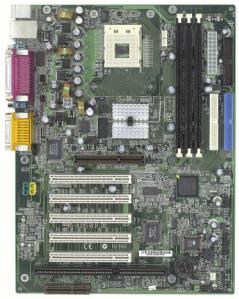
MSI 845 PRO4
MICRO-STAR INTERNATIONAL
MS-6391 ATX Mainboard
Version 1.0
G52-MA00362
I

Manual Rev : 1.0
Release Date : Jul. 2001
FCC-B Radio Frequency Interference Statement
This equipment has been tested and found to comply with the limits for a class B digital device, pursuant to part 15 of the FCC rules. These limits are designed to provide reasonable protection against harmful interference when the equipment is operated in a commercial environment. This equipment generates, uses and can radiate radio frequency energy and, if not installed and used in accordance with the instruction manual, may cause harmful interference to radio communications. Operation of this equipment in a residential area is likely to cause harmful interference, in which case the user will be required to correct the interference at his own expense.
Notice 1
The changes or modifications not expressly approved by the party responsible for compliance could void the user’s authority to operate the equipment.
Notice 2
Shielded interface cables and A.C. power cord, if any, must be used in order to comply with the emission limits.
VOIR LA NOTICE D’INSTALLATION AVANT DE RACCORDER AU RESEAU.
Micro-Star International MS-6391
Tested to comply with
FCC Standard
For Home or Office Use
II
Copyright Notice
The material in this document is the intellectual property of MICRO-STAR INTERNATIONAL. We take every care in the preparation of this document, but no guarantee is given as to the correctness of its contents. Our products are under continual improvement and we reserve the right to make changes without notice.
Trademarks
All trademarks used in this manual are the property of their respective owners.
Intel and Pentium are registered trademarks of Intel Corporation. PS/2 and OS/2 are registered trademarks of IBM Corporation.
Windows 98, Windows ME, and Windows NT are registered trademarks of Microsoft.
Netware is a registered trademark of Novell.
Award is a registered trademark of Award Software Inc.
Revision History
Revision |
Revision History |
Date |
V1.0 |
First Release |
Jul. 2001 |
III

Safety Instructions
1.Always read the safety instructions carefully.
2.Keep this User’s Manual for future reference.
3.Keep this equipment away from humidity.
4.Lay this equipment on a reliable flat surface before setting it up.
5.The openings on the enclosure are for air convection hence protects the equipment from overheating. DO NOT COVER THE OPENINGS.
6.Make sure the voltage of the power source and adjust properly 110/220V before connecting the equipment to the power inlet.
7.Place the power cord such a way that people can not step on it. Do not place anything over the power cord.
8.Always unplug the Power Cord before inserting any add-on card or module.
9.All cautions and warnings on the equipment should be noted.
10.Never pour any liquid into the opening that could damage or cause electrical shock.
11.If any of the following situations arises, get the equipment checked by a service personnel:
The power cord or plug is damaged Liquid has penetrated into the equipment
The equipment has been exposed to moisture
The equipment has not work well or you can not get it work according to User’s Manual.
The equipment has dropped and damaged
If the equipment has obvious sign of breakage
12.DO NOT LEAVE THIS EQUIPMENT IN AN ENVIRONMENT UNCONDITIONED, STORAGE TEMPERATURE ABOVE 600 C (1400F), IT MAY DAMAGE THE EQUIPMENT.
CAUTION: Danger of explosion if battery is incorrectly replaced. Replace only with the same or equivalent type recommended by
the manufacturer.
IV
|
Contents |
Chatper 1 Introduction .......................................................................... |
1-1 |
Mainboard Specifications ................................................................ |
1-2 |
Mainboard Layout ............................................................................ |
1-4 |
Quick Components Guide ............................................................... |
1-5 |
Chatper 2 Hardware Setup .................................................................. |
2-1 |
Central Processing Unit: CPU ......................................................... |
2-2 |
CPU Installation Procedures .................................................... |
2-2 |
CPU Core Speed Derivation Procedure ................................... |
2-3 |
Installing the CPU Fan .............................................................. |
2-4 |
Memory Installation ......................................................................... |
2-6 |
Memory Bank Configuration .................................................... |
2-6 |
Module Installation Procedures............................................... |
2-7 |
Power Supply .................................................................................... |
2-8 |
ATX 20-pin Power Connector .................................................. |
2-8 |
ATX 12V Power Connector: JPW1............................................ |
2-8 |
Back Panel ....................................................................................... |
2-10 |
Mouse Connector ..................................................................... |
2-10 |
Keyboard Connector ................................................................ |
2-11 |
USB Connectors ....................................................................... |
2-11 |
Serial Port Connectors: COM A & COM B ............................. |
2-12 |
Midi/Joystick/Audio Port Connectors ................................. |
2-12 |
V
LAN Jack (RJ-45) (optional) .................................................... |
2-13 |
Parallel Port Connector: LPT1 ................................................ |
2-14 |
Connectors ...................................................................................... |
2-15 |
Floppy Disk Drive Connector: FDD1 ..................................... |
2-15 |
Hard Disk Connectors: IDE1 & IDE2 .................................... |
2-16 |
Fan Power Connectors: P_FAN1/C_FAN1/S_FAN1 ......... |
2-17 |
Case Connector: F_P1 & F_P2 (optional) .............................. |
2-18 |
Power Saving Switch Connector: JGS1 ................................. |
2-21 |
Power Saving LED Connector: JGL1 ..................................... |
2-22 |
Wake On Ring/Wake On LAN Connectors .......................... |
2-23 |
CD-In/AUX Line-In/Modem-In Connectors ....................... |
2-24 |
IrDA Infrared Module Connector: IR1 & IR2 (optional) ...... |
2-25 |
USB PC to PC Connector: USB1 & USB2 (optional) ............. |
2-26 |
Front Audio Connector: JAUDIO1 & JAUDIO2 (optional) .. |
2-27 |
Jumpers ............................................................................................ |
2-29 |
Clear CMOS Jumper: JBAT1 .................................................... |
2-29 |
Onboard Audio Jumper: JP1 (optional) ................................. |
2-30 |
Slots .................................................................................................. |
2-31 |
AGP (Accelerated Graphics Port) Slot ................................... |
2-31 |
PCI Slots .................................................................................... |
2-31 |
ISA (Industry Standard Architecture) Slot (optional) .......... |
2-32 |
CNR (Communication & Networking Riser) Slot ................ |
2-32 |
Chapter 3 Award® BIOS Setup ............................................................ |
3-1 |
Entering Setup .................................................................................. |
3-2 |
Control Keys ...................................................................................... |
3-2 |
Getting Help ...................................................................................... |
3-3 |
Main Menu ........................................................................................ |
3-4 |
Standard CMOS Features ................................................................ |
3-6 |
VI
Advanced BIOS Features ................................................................. |
3-9 |
Advanced Chipset Features .......................................................... |
3-14 |
Integrated Peripherales .................................................................. |
3-17 |
Power Management Setup ............................................................. |
3-22 |
PnP/PCI Configurations ............................................................... |
3-27 |
PC Health Status............................................................................. |
3-29 |
Frequency/Voltage Control ........................................................... |
3-31 |
Load Fail-Safe/Optimized Defaults ............................................. |
3-33 |
Set Supervisor/User Password..................................................... |
3-34 |
Save & Exit Setup/Exit without Saving ....................................... |
3-36 |
Appendix A: Glossary ........................................................................... |
B-1 |
VII

Introduction
|
1 |
|
Introduction |
||
|
The 845 Pro4 (MS-6391) ATX mainboard is a high-performance computer mainboard based on Intel® 82845 & 82801BA chipsets. The 845 Pro4 is designed for Intel® Pentium® 4 processor in the 478 pin package that delivers a high performance and professional desktop platform solution.
The Intel® 82845 Memory Controller Hub (MCH) provides the processor interface, SDRAM interface, AGP interface and hub interface. It supports: a single processor with a data transfer rate of 400MHz, SDRAM at 133MHz operation (PC133), AGTL+ host bus with integrated termination supporting 32-bit host addressing, 1.5V AGP interface with 4x SBA/data transfer and 2x/4x fast write capability, and 8-bit, 66MHz 4x hub interface to the Intel ICH2.
The 82801BA I/O Controller Hub 2 (ICH2) provides the I/O subsystem with access to the rest of the system and additionally integrates many I/O functions. It supports: upstream hub interface for access to the Intel MCH, 2-channel Ultra ATA/100 bus master IDE controller, USB controller 1.1 (expanded capabilities for 4 ports), I/O APIC, SMBus controller, FWH interface, LPC interface, AC’97 2.1 interface, PCI 2.2 interface, integrated system management controller, and integrated LAN controller.
This chapter includes the following topics: |
|
Mainboard Specifications |
1-2 |
Mainboard Layout |
1-4 |
Quick Components Guide |
1-5 |
1-1

Chapter 1
Mainboard Specifications
CPU
Support Intel® Pentium® 4 processor in FC-PGA2 package Support 1.3GHz, 1.4GHz and up to 2GHz
Chipset
Intel® 845 chipset (593 FC-BGA)
-Support 400MHz Intel NetBurst micro-architecture bus
-Support SDRAM at 133MHz operation (PC133)
-100MHz FSB
-AGP 2x/4x universal slot
Intel® ICH2 chipset (360BGA)
-Two full IDE channels, support up to ATA100
-AC’ 97 controller integrated
-LPC interface for SIO
-Integrated 10/100 Ethernet
Main Memory
Three 168-pin SDRAM sockets
Support a total of 3GB memory, using 16/64/128/256/512Mb technology
Slots
One AGP 2x/4x slot
Five PCI 2.2 32-bit Master PCI Bus slots (support 3.3v/5v PCI bus)
One CNR (Communication Network Riser) slot
One ISA (Industry Standard Architecture) slot (optional)
On-Board IDE
An IDE controller on the ICH2 chipset provides IDE HDD/CDROM with PIO, Bus Master and Ultra DMA66/100 operation modes
Can connect up to four IDE devices
1-2

Introduction
On-Board Peripherals
On-Board Peripherals include:
-One floppy port supports two FDDs with 360KB, 720KB, 1.2MB, 1.44MB and 2.88MB.
-Two serial ports (COM A + COM B)
-One parallel port supports SPP/EPP/ECP mode
-Four USB ports (Rear * 2/Front * 2)
-One RJ-45 connector (optional)
-One audio/game port
Audio
ICH2 chipset integrated
ADI 1885
-AC’ 97 compliant
-Support two channel audio
BIOS
The mainboard BIOS provides “Plug & Play” BIOS which detects the peripheral devices and expansion cards of the board automatically.
The mainboard provides a Desktop Management Interface (DMI) function which records your mainboard specifications.
Dimension
ATX Form Factor
Mounting
6 mounting holes
1-3
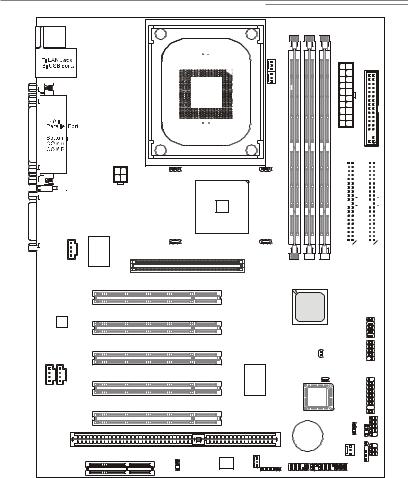
Chapter 1
Mainboard Layout
T: mouse
B: keyboard
P_FAN1
C_FAN1 
D-LED |
Intel |
|
Top : |
|
845 |
Game port |
|
|
Bottom: |
|
chipset |
Line-Out |
|
|
Line-In |
Winbond W83627HF |
|
Mic |
|
|
CD_IN1 |
AGP Slot |
|
|
|
Power Supply
ATX
FDD
|
|
|
|
|
|
|
IDE 2 |
|
IDE 1 |
|
|
|
|
|
|
||||||
|
|
|
|
|
||||||
|
|
|
|
|
|
|
|
|
|
|
|
|
|
|
|
|
|
|
|
|
|
|
|
|
|
|
|
|
|
|
|
|
|
PCI Slot 1 |
|
ICH2 |
|
|
|
|
|
|
||
Codec |
PCI Slot 2 |
|
|
USB1 |
|
|
|
|
|||
|
|
|
JGS1 |
USB2 |
|
|
|
|
|
||
MDM_IN1 |
PCI Slot 3 |
|
|
(optional) |
|
|
|
|
|||
|
|
Winbond |
J3 |
|
|
|
|
|
|
||
|
PCI Slot 4 |
W83628F |
|
|
|
AUX_IN1 |
|
FWH |
F_P1 |
||
|
|
|
|||
|
|
|
|
||
|
PCI Slot 5 |
|
|
JGL1 |
|
|
|
|
BATT |
JBAT1 |
|
|
|
|
|
||
|
|
|
+ |
|
|
|
ISA Slot (optional) |
JWOL1 |
S_FAN1 |
||
|
JAUDIO2 |
|
|||
|
Winbond |
|
(optional) |
IR1 |
|
CNR |
W83629D |
|
|
||
JP1(optional) |
JMDM1 |
JAUDIO1 |
|||
|
|||||
IR2 (optional) F_P2 (optional)
MS-6391 ATX Mainboard
1-4

Introduction
Quick Components Guide
Component |
Function |
Reference |
Socket 478 |
Installing CPU |
p. 2-2 |
DIMM 1~3 |
Installing DIMMs |
p. 2-7 |
ATX Power Connector |
Installing power supply |
p. 2-8 |
JPW1 |
Connecting to a 12V power |
p. 2-8 |
FDD1 |
Connecting to Floppy disk drive |
p. 2-15 |
IDE 1~2 |
Connecting to IDE devices |
p. 2-16 |
P_FAN1 |
Connecting to Power Supply fan |
p. 2-17 |
C_FAN1 |
Connecting to CPU fan |
p. 2-17 |
S_FAN1 |
Connecting to System fan |
p. 2-17 |
F_P1 & F_P2 |
Case connector |
p. 2-18 |
JGS1 |
Connecting to power saving switch |
p. 2-20 |
JGL1 |
Connecting to power saving LED |
p. 2-21 |
JMDM1 |
Connecting to modem module |
p. 2-22 |
JWOL1 |
Connecting to LAN module |
p. 2-22 |
CD_IN1 |
CD-in connector |
p. 2-23 |
AUX_IN1 |
Aux line-in connector |
p. 2-23 |
MDM_IN1 |
Modem-in connector |
p. 2-23 |
IR1 & IR2 |
Connecting to IrDA module |
p. 2-24 |
USB1 & USB2 |
USB PC to PC connector |
p. 2-25 |
JBAT1 |
Clear CMOS jumper |
p. 2-29 |
AGP Slot |
Installing AGP card |
p. 2-31 |
PCI Slots |
Installing expansion cards |
p. 2-31 |
ISA Slots |
Installing expansion cards |
p. 2-31 |
CNR Slot |
Installing CNR card |
p. 2-31 |
1-5

Hardware Setup
|
2 |
|
Hardware Setup |
||
|
This chapter provides you with the information about hardware setup procedures. While doing the installation, be careful in holding the components and follow the installation procedures. For some components, if you install in the wrong orientation, the components will not work properly.
Use a grounded wrist strap before handling computer components. Static electricity may damage the components.
This chapter contains the following topics: |
|
Central Processing Unit: CPU |
2-2 |
Memory Installation |
2-6 |
Power Supply |
2-8 |
Back Panel |
2-10 |
Connectors |
2-15 |
Jumpers |
2-29 |
Slots |
2-31 |
2-1
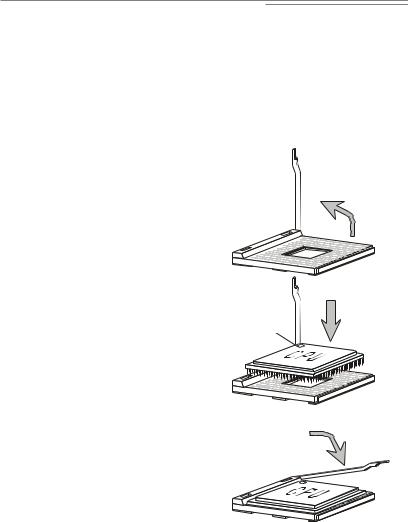
Chapter 2
Central Processing Unit: CPU
The mainboard supports Intel® Pentium® 4 processor in FC-PGA2 package. The mainboard uses a CPU socket called PGA478 for easy CPU installation. When you are installing the CPU, make sure the CPU has a heat sink and a cooling fan attached on the top to prevent overheating.
If you do not find the heat sink and cooling fan, contact your dealer to purchase and install them before turning on the computer.
CPU Installation Procedures
1.Pull the lever sideways away from the socket. Then, raise the lever up to a 90-degree angle.
2.Look for the dot/cut edge. The dot/cut edge should point towards the lever pivot. The CPU will only fit in the correct orientation.
Slidinging Plate
Plate
DotDot/Cut/ Cut edge
Open Lever
Open Lever
Close Lever
Close
Lever
3. Hold the CPU down firmly, and then close the lever to complete the installation.
2-2

Hardware Setup
CPU Core Speed Derivation Procedure
If |
CPU Clock |
= |
100MHz |
|
Core/Bus ratio |
= |
14 |
then |
CPU core speed |
= |
Host Clock x Core/Bus ratio |
|
|
= |
100MHz x 14 |
|
|
= |
1.4GHz |
1. Overheating
The issue of heat will seriously damage the CPU and system, always make sure the cooling fan can work properly to protect the CPU from overheating.
2. Overclocking
This motherboard is designed to support overclocking. WARNING! However, please make sure your components are able to
tolerate such abnormal setting, while doing overclocking. Any attempt to operate beyond product specifications is not recommended. We do not guarantee the damages or risks caused by inadequate operation or beyond product specifications.
2-3
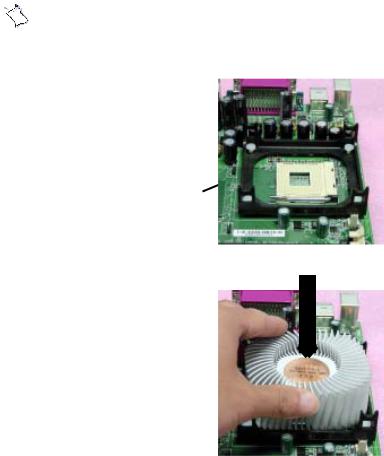
Chapter 2
Installing the CPU Fan
As processor technology pushes to faster speeds and higher performance, thermal managment becomes increasingly important. To dissipate heat, you need to attach the CPU cooling fan and heatsink on top of the CPU. Follow the instructions below to install the heatsink/ fan.

 NOTE: The figures in this section are for reference only. Actual mainboard layout may be different from the one you purchased.
NOTE: The figures in this section are for reference only. Actual mainboard layout may be different from the one you purchased.
1.Locate the CPU and its retention mechanism on the mainboard.
Retention Mechanism
2. Position the heatsink onto the retention mechanism.
2-4

Hardware Setup
3.Mount the fan on top of the heatsink. Press down the fan until its four clips get wedged in the holes of the retention mechanism.
4. Press the two levers down to |
levers |
|
|
fasten the fan. Each lever can |
|
be pressed down in only |
|
ONE direction. |
|
5.Connect the fan power cable from the mounted fan to the 3-pin fan power connector on the mainboard.
Fan power cable 
2-5
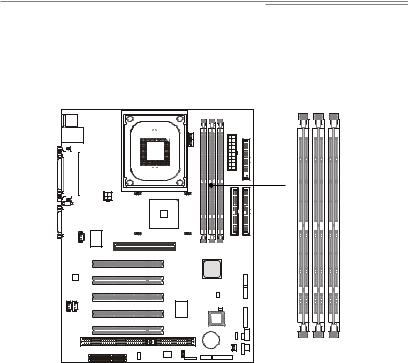
Chapter 2
Memory Installation
Memory Bank Configuration
The mainboard supports a maximum memory size of 3GB. It provides three 168-pin unbuffered SDRAM DIMM (Double In-Line Memory Module) sockets and supports 64MB to 512MB technology.
DIMM 1 ~ 3
Synchronous DRAM is a type of dynamic RAM memory chip that has been widely used starting in the latter part of the 1990s. SDRAMs are based on standard dynamic RAM chips, but have sophisticated features that make them considerably faster. First, SDRAM chips are fast enough to be synchronized with the CPU's clock, which eliminates wait states. Second, the SDRAM chip is divided into two cell blocks, and data is interleaved between the two so that while a bit in one block is being accessed, the bit in the other is being prepared for access. This allows SDRAM to burst the second and subsequent, contiguous characters at a rate of 10ns, compared to 60ns for the first character.
SDRAM provides 800 MBps or 1 GBps data transfer depending on whether the bus is 100MHz or 133MHz.
2-6

Hardware Setup
Memory Installation Procedures
You can install memory modules in any combination as follows:
Socket |
Memory Module |
Total Memory |
|
Socket 1 |
64MB, 128MB, |
64MB ~ 1GB |
|
(Bank0 & Bank1) |
256MB, 512MB, 1GB |
|
|
Socket 2 |
64MB, 128MB, |
64MB ~ 1GB |
|
(Bank2 & Bank3) |
256MB, 512MB, 1GB |
||
|
|||
Socket 3 |
64MB, 128MB, |
64MB ~ 1GB |
|
(Bank4 & Bank5) |
256MB, 512MB, 1GB |
||
|
|||
Total System Memory |
64MB ~ 3GB |
||

 Note: As 845 chipset does not properly support the PC100 memory, it is strongly recommended to install PC133 DIMMs for the better system performance and stability. We do not guarantee the system stability when installing PC100 DIMMs.
Note: As 845 chipset does not properly support the PC100 memory, it is strongly recommended to install PC133 DIMMs for the better system performance and stability. We do not guarantee the system stability when installing PC100 DIMMs.
Installing DIMM Modules
1.The DIMM slot has 2 Notch Keys “VOLT and DRAM”, so the DIMM memory module can only fit in one direction.
Front View |
Rear View |
2.Insert the DIMM memory module vertically into the DIMM slot. Then push it in.
DRAM VOLT
3.The plastic clip at the side of the DIMM slot will automatically close.
2-7

Chapter 2
Power Supply
The mainboard supports ATX power supply for the power system. Before inserting the power supply connector, always make sure that all components are installed properly to ensure that no damage will be caused.
ATX 20-Pin Power Connector
This connector allows you to connect to an ATX power supply. To connect to the ATX power supply, make sure the plugs of the power supply is inserted in the proper orientation and the pins are aligned. Then push down the power supply firmly into the connector. The power connector supports instant power on function which means that system will boot up immediately when the power supply connector is inserted on the board.
ATX 12V Power Connector: JPW1
This 12V power connector is used to provide power to the CPU.
2-8
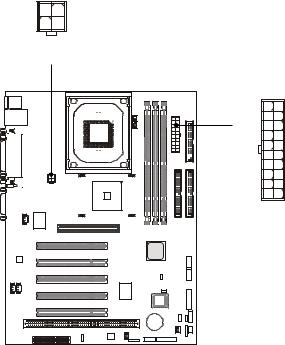
Hardware Setup
2 |
1 |
|
4 |
3 |
|
|
JPW1 |
|
|
11 |
1 |
|
20 |
10 |
|
ATX Power |
|
|
Connector |
|
PIN |
SIGNAL |
1 |
GND |
2 |
GND |
3 |
12V |
4 |
12V |
JPW1 Pin Definition
PIN |
SIGNAL |
PIN |
SIGNAL |
1 |
3.3V |
11 |
3.3V |
2 |
3.3V |
12 |
-12V |
3 |
GND |
13 |
GND |
4 |
5V |
14 |
PS_ON |
5 |
GND |
15 |
GND |
6 |
5V |
16 |
GND |
7 |
GND |
17 |
GND |
8 |
PW_OK |
18 |
-5V |
9 |
5V_SB |
19 |
5V |
10 |
12V |
20 |
5V |
ATX Power Connector Pin Definition
2-9
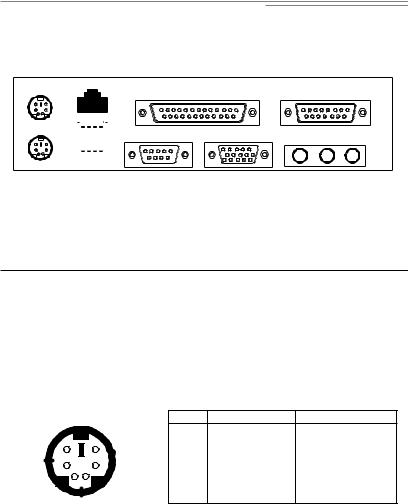
Chapter 2
Back Panel
The Back Panel provides the following connectors:
Mouse |
|
|
LAN |
Paraller Port |
Midi/Joystick Port |
|||||||||||||
|
|
|
|
|
|
|
|
|
|
|
|
|
|
|
|
|
|
|
|
|
|
|
|
|
|
|
|
|
|
|
|
|
|
|
|
|
|
|
|
|
|
|
|
|
|
|
|
|
|
|
|
|
|
|
|
|
|
|
|
|
|
|
|
|
|
|
|
|
|
|
|
|
|
|
|
|
|
|
|
|
|
|
|
|
|
|
|
|
|
|
|
|
|
|
|
|
|
|
|
|
|
|
|
|
|
|
|
|
|
|
|
|
|
|
|
|
|
|
|
|
|
|
|
|
|
|
|
|
|
|
|
|
|
|
|
|
|
|
|
|
|
|
|
|
|
|
|
|
|
|
|
|
|
|
|
|
|
|
|
|
|
|
|
|
|
|
|
|
|
|
|
|
|
|
|
|
|
|
|
|
|
|
|
|
|
|
|
|
|
|
|
|
|
|
|
|
|
|
|
|
|
|
|
|
|
|
|
|
|
|
|
|
|
|
|
|
|
|
|
|
|
|
|
|
|
|
|
Keyboard USB Ports |
COM A |
COM B |
L-Out L-In MIC |
Mouse Connector
The mainboard provides a standard PS/2® mouse mini DIN connector for attaching a PS/2® mouse. You can plug a PS/2® mouse directly into this connector. The connector location and pin assignments are as follows:
|
|
PIN |
SIGNAL |
DESCRIPTION |
|
|
|
1 |
Mouse DATA |
Mouse DATA |
|
6 |
5 |
2 |
NC |
No connection |
|
4 |
3 |
3 |
GND |
Ground |
|
4 |
VCC |
+5V |
|||
2 |
1 |
||||
5 |
Mouse Clock |
Mouse clock |
|||
|
|
6 |
NC |
No connection |
|
PS/2 Keyboard (6-pin Female) |
|
Pin Definition |
|||
2-10
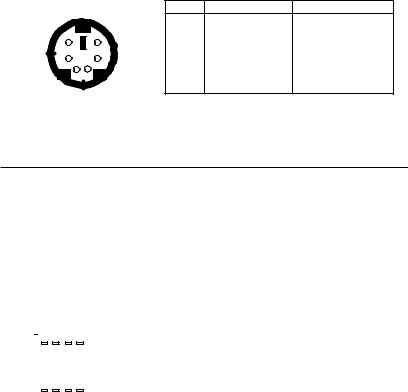
Hardware Setup
Keyboard Connector
The mainboard provides a standard PS/2® keyboard mini DIN connector for attaching a PS/2® keyboard. You can plug a PS/2® keyboard directly into this connector.
|
|
|
PIN |
SIGNAL |
DESCRIPTION |
|
|
|
1 |
Keyboard DATA |
Keyboard DATA |
6 |
5 |
|
2 |
N C |
No connection |
4 |
|
3 |
3 |
GND |
Ground |
|
4 |
VCC |
+5V |
||
2 |
1 |
|
|||
|
5 |
Keyboard Clock |
Keyboard clock |
||
|
|
|
6 |
N C |
No connection |
PS/2 Keyboard (6-pin Female) |
Pin Definition |
|
USB Connectors
The mainboard provides a UHCI (Universal Host Controller Interface) Universal Serial Bus root for attaching USB devices such as keyboard, mouse or other USB-compatible devices. You can plug the USB device directly into ths connector.
|
|
|
|
|
|
|
|
|
|
|
|
|
|
PIN |
SIGNAL |
DESCRIPTION |
|
|
|
|
|
|
|
|
|
|
|
|
|
|
1 |
VCC |
+5V |
1 |
2 |
3 |
4 |
|
|
|
2 |
-Data 0 |
Negative Data Channel 0 |
|||||||
|
|
|
|
|
|
|
|
|
|
|
|
|
|
3 |
+Data0 |
Positive Data Channel 0 |
|
|
|
|
|
|
|
|
|
|
|
|
|
||||
|
|
|
|
|
|
|
|
|
|
|
|
|
|
4 |
GND |
Ground |
|
|
|
|
|
|
|
|
|
|
|
|
|
||||
5 |
6 |
7 |
8 |
|
|
|
5 |
VCC |
+5V |
|||||||
|
|
|
6 |
-Data 1 |
Negative Data Channel 1 |
|||||||||||
|
|
|
|
|
|
|
|
|
|
|
|
|
|
7 |
+Data 1 |
Positive Data Channel 1 |
|
|
|
|
|
|
|
|
|
|
|
|
|
||||
|
|
|
|
|
|
|
|
|
|
|
|
|
|
8 |
GND |
Ground |
|
|
|
|
|
|
|
|
|
|
|
|
|
||||
|
|
|
|
|
|
|
||||||||||
|
|
USB Ports |
|
|
USB Port Description |
|||||||||||
2-11
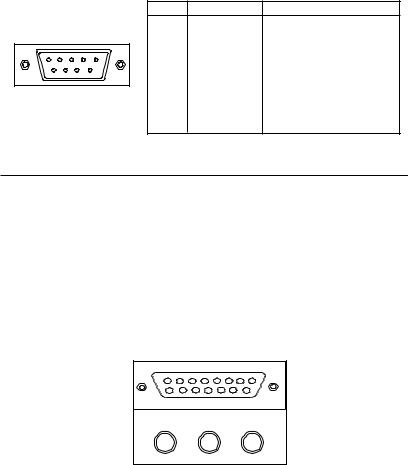
Chapter 2
Serial Port Connector: COM A & COM B
The mainboard offers two 9-pin male DIN connectors for serial port COM A and COM B. The ports are 16550A high speed communication ports that send/receive 16 bytes FIFOs. You can attach a serial mouse or other serial devices directly to them.
|
|
|
PIN |
SIGNAL |
DESCRIPTION |
|
|
|
1 |
DCD |
Data Carry Detect |
1 2 |
3 |
4 5 |
2 |
SIN |
Serial In or Receive Data |
|
|
|
3 |
SOUT |
Serial Out or Transmit Data |
|
|
|
4 |
DTR |
Data Terminal Ready |
|
|
|
5 |
GND |
Ground |
6 |
7 8 |
9 |
6 |
DSR |
Data Set Ready |
7 |
RTS |
Request To Send |
|||
9-Pin Male DIN Connectors |
8 |
CTS |
Clear To Send |
||
|
|
|
9 |
RI |
Ring Inticate |
Pin Definition
Midi/Joystick/Audio Port Connector
The mainboard provides a 15-pin female connector for connecting a game joysticks/pads or MIDI devices.
The three ports at bottom provide the mainboard audio functions: Line Out is a connector for headphone or speakers. Line In is used for external CD player, tape players or other audio devices to be recorded by your computer or played through the Line Out. Mic is a connector for the microphone.
Midi / Joystick
L-out |
L-in |
MIC |
2-12

Hardware Setup
LAN Jack (RJ-45) (optional)
The mainboard provides one standard RJ-45 jack for connection to Local Area Network (LAN). You can connect a network cable to the LAN jack.
|
|
|
|
|
|
|
|
|
|
|
PIN |
SIGNAL |
DESCRIPTION |
|
|
|
|
|
|
|
|
|
|
|
1 |
RDN |
Receive Differential Pair |
|
|
|
|
|
|
|
|
|
|
|
2 |
RDP |
Receive Differential Pair |
|
|
|
|
|
|
|
|
|
|
|
3 |
GND |
Ground |
|
|
|
|
|
|
|
|
|
|
|
4 |
GND |
Ground |
|
|
|
|
|
|
|
|
|
|
|
5 |
GND |
Ground |
|
|
|
|
|
|
|
|
|
|
|
|||
LAN RJ-45 Jack |
6 |
GND |
Ground |
||||||||||
|
|
|
|
|
|
|
|
|
|
|
7 |
TDN |
Transmit Differential Pair |
|
|
|
|
|
|
|
|
|
|
|
8 |
TDP |
Transmit Differential Pair |
Pin Definition
2-13
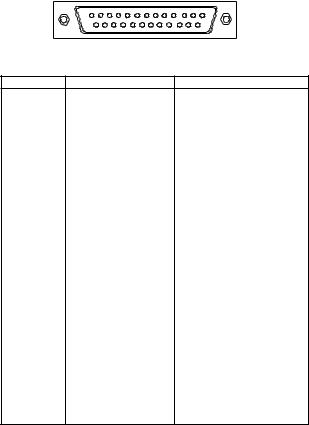
Chapter 2
Parallel Port Connector: LPT1
The mainboard provides a 25-pin female centronic connector for LPT. A parallel port is a standard printer port that supports Enhanced Parallel Port (EPP) and Extended Capabilities Parallel Port (ECP) mode.
|
13 |
1 |
|
25 |
14 |
PIN |
SIGNAL |
DESCRIPTION |
1 |
STROBE |
Strobe |
2 |
DATA0 |
Data0 |
3 |
DATA1 |
Data1 |
4 |
DATA2 |
Data2 |
5 |
DATA3 |
Data3 |
6 |
DATA4 |
Data4 |
7 |
DATA5 |
Data5 |
8 |
DATA6 |
Data6 |
9 |
DATA7 |
Data7 |
10 |
ACK# |
Acknowledge |
11 |
BUSY |
Busy |
12 |
PE |
Paper End |
13 |
SELECT |
Select |
14 |
AUTO FEED# |
Automatic Feed |
15 |
ERR# |
Error |
16 |
INIT# |
Initialize Printer |
17 |
SLIN# |
Select In |
18 |
GND |
Ground |
19 |
GND |
Ground |
20 |
GND |
Ground |
21 |
GND |
Ground |
22 |
GND |
Ground |
23 |
GND |
Ground |
24 |
GND |
Ground |
25 |
GND |
Ground |
Pin Definition
2-14
